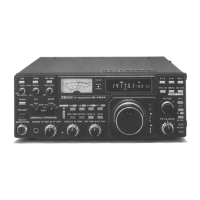7-3
NOISE BLANKER
[NBl
OPERATION
When
pulse noise, such
as ignition
noise from
vehicles,
makes recep-
tion difficult,
the NOISE
BLANKER
effectively reduces this kind of
interference.
la la
GAIN—
vox—
DELAY
NB WIDE
NB LEVEL
1)
Rotate the NB
LEVEL
CONTROL clockwise
from
the
OFF
position beyond
the detent
when
pulse
noise is present.
2)
The noise
is suppressed
and
weak
signals
which
may
otherwise
have been covered
by noise can be received.
3)
When
the NOISE BLANKER
TIMING
SWITCH is set in the
WIDE (locked IN)
position,.the noise blanker
effectively
removes
long duration pulse noise such
as
the "woodpecker".
NOTE:
The
noise
blanker
may not
work
as
well when strong
signals are on nearby frequencies, or when the noise is
continuous rather than pulse noise.
If
the
desired receive
signal becomes distorted by
the
action of
the noise blanker, either place the NB WIDE
SWITCH
in
the OUT position, or
reduce
the NB LEVEL
CONTROL (turn
counterclockwise)
until
the
signal
is
clear.
7
-4
CW SEMi/FULL
BREAK-IN
The IC-751A
has
both semi break-in
and full break-in
CW
capability
OPERATION
when using the VOX function.
This means the transmit/receive
switching
is
performed
automatically
by the transceiver
whenever
the keying
starts or
stops.
The
receive
to transmit
switching time is
almost
instantaneous
whereas
the transmit
to
receive switching
time
may
be varied
by an
adjustment.
•SEMI BREAK-IN OPERATION
USING
A
STRAIGHT
KEY
1
)
Set the controls and
switches
as
shown in the table.
SWITCH/CONTROL
POSITION
MODE
CW or
CW
NARROW
VOX
ON (IN)
KEY
SPEED OFF
VOX DELAY
10 O'CLOCK
TRANSMIT/RECEIVE
RECEIVE
2)
Set
the transmit
release delay time
to
suit your keying
speed
by
adjusting the VOX
DELAY
CONTROL while keying. Rotate
the
control
clockwise to increase the
delay.
3)
Begin sending with the
CW
key
and the transmitter will switch
between
transmit
and
receive
automatically.
•
SEMI BREAK-IN
OPERATION WITH
AUTOMATIC KEYING USING AN
IAMBIC PADDLE
Wiring for
an iambic
paddle.
DOT
°
i
t
DASH
Automatic keying
is possible simply by
connecting an
iambic
paddle.
The
operator merely controls
the number of dots or dashes
trans-
mitted
without regard
to spaces
between
the elements, or the
timing
of the elements, within
a character. When used correctly,
the
result-
ing
CW is generally easier and more enjoyable
to
copy
at
the
receiv-
ing end.
1
)
Set the switches and controls
as shown in the table.
NOTE:
The CW WEIGHT
CONTROL is installed on the electro-
nick keyer
unit. Refer
to SECTIONS
12-
3
(3)
and
13-2
for the
control
location.
-
33
-

